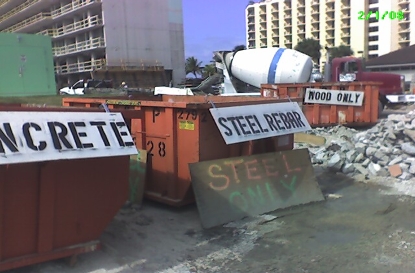One of the most important aspects of sustainability is the management of waste. Waste management is threefold including
reduction of waste, recycling and the reuse of materials. Each year millions of
tons of construction waste is sent to landfills or illegally dumped on land!
Remember when our parents would tell us to eat our food because there were kids
in Africa starving? I never quite got why they used that particular analogy,
but its principle goes to the heart of being wasteful. We should properly use
everything our disposal, not dispose of it.

Eliminating waste seems like a daunting task but really it
is within our reach. We first must realize that we can do it and then plan
carefully. Caution: this may include using your brain and even your money! We
eliminate waste when we build durable, quality products that last long and are
not easily disposed of. The longer a product is used and maintained, the less
waste that happens. As project managers, we are learning that planning and estimating
correctly can play a huge role in the elimination. I remember in Comprehensive
Estimating, having to constantly factor in 5-10% waste. Why is that? More care,
accurate planning helps dramatically reduce those questions of waste. BIM
modeling is just one of the many tools that can help a project manager at the
front end of a project. The computer calculates all of the quantities
accurately and can even give an accurate estimation of a schedule that could
reduce how much and how long we are incurring waste. But the computer doesn’t build the model itself so being
painstaking and focused helps for more accurate results which means that orders
for quantities of materials can go out with less variance and disposal of the
left overs.




The way the building is designed in the first place also has
a lot to do with adding to the waste. If the dimensions of the building of the
building take into consideration the sizes that the material suppliers produce
instead of making other dimensions that require for materials to cut and unable
to be used, therefore wasted. Not only that, but designing for dis-assembly and
reuse means that systems come together in such a way that the building can be
dismantled without destroying the use of its members. This requires some real
patience and thought on the part of the architect to design assemblages and
joinery that make these things possible instead of slapping everything together
with glue. The Loblolly House by Keiran Timberlake is a great example of this
concept of attention
to details of assemblage.

This leads to the
next aspect of waste management, reuse. Once a building is dismantled, it does
not all have to go to a dumpster. Finding people who could use the leftovers
for other purposes is a great way to make sure everything is being put to good
use and not put in a dumpster. Reuse goes beyond reuse of materials, but also
the use of old buildings. Why does every business have to have a new one.
Professor Sullivan has been known to say that the greenest building is the one
we DON’T build. It’s so true!
construction waste removali
ReplyDeleteLondon Waste Removal Service - House builders or construction renovation service take place all over London. We offer removals all types of waste or construction rubbish cleaner. We offer office, furniture, garden, junk and rubbish clearance.
to get more - http://londonwasteremovalservice.co.uk/builders/
Nice blog post...very informative. Thanks for sharing..
ReplyDeleteConstruction waste removal winnipeg With the best quality of work we provide full Bonding and liability insurance on all jobs.